The Record Store Years (Side Trip): Led Zeppelin at Fillmore East, January 1969
A memoir of 25 years (1975-2000) spent working in the world of records & music in Seattle, with occasional side trips into writings on Led Zeppelin and other adventures from my musical life.
This show was my second rock concert, I was 12 years old and as a Christmas present my parents let me choose a Fillmore East show from the weekly ad in the Sunday New York Times, and said they would take me. Enamored with the 17-minute “Inna Gadda Da Vida” I heard regularly on WNEW FM, I chose Iron Butterfly, not realizing that my life would be changed forever by Led Zeppelin.
Years later I wrote this recollection/review for my fanzine Proximity.
Iron Butterfly/Led Zeppelin/Porter’s Popular Preachers, Fillmore East, New York January 31, 1969
From Proximity #10, July 1993
Led Zeppelin’s New York debut came a mere two weeks after the U.S. release of their first album and it was the first exposure most New Yorkers had to the band.
Those in the know were already aware of Jimmy Page, and of course there were a handful of people who must have already picked up the album and become familiar with it. More than a few members of the audience had likely also seen the Page-led Yardbirds at the Anderson Theatre a few blocks north of the Fillmore the previous March.
Above: Concert and album ads from the Village Voice of January 30, 1969
Regardless of this, nothing could have prepared anyone for the power of this performance. Led Zeppelin were louder, brasher, and more exciting than just about anything imaginable at that time. Despite their status as a warmup act to then-superstars Iron Butterfly, Zeppelin’s two encores left the audience deliriously shouting for more even after the house lights went up, and Iron Butterfly delayed coming on for 45 minutes. As I recall it they played a lack-luster set that was received in kind.
The concert I saw was the early show on the first of a two-night stand, and not even Greenwich Village word of mouth had gone around about the Fillmore’s weekend program yet. Recorded evidence indicates that the February first shows the next night were even hotter, but the Led Zeppelin I witnessed on that cold winter night was a fire-breathing dragon of an already well-oiled machine, and everyone in that hall was equally blown away by it.
Above: The free program available to all Fillmore East audience members for the weekend of January 31st and February 1st, 1969
------------------------------------------------------------------------------------------------
Porter’s Popular Preacher’s short set is received with appreciative amusement, and after a short break the lights go down again and Bill Graham takes the microphone. “Please welcome from England, Led Zeppelin,” and immediately the band launches into “Train Kept A-Rollin’.”
It’s loud. Very loud. The drums sound like thunder and you can feel the bass; the guitar is like a physical presence in the hall, and from somewhere within this thunderous muddy roar comes a wail that pierces through it all. It takes a couple of seconds to realize it’s the vocalist.
After a verse he hunches over and starts wailing on a harmonica, and as the soundman gets his bearings the components become audible just in time for Jimmy Page to break into a breathless guitar solo. The song ends quickly, and the audience is almost too stunned to react. Just as a few people remember to applaud, Jimmy launches into “I Can’t Quit You.”
He comes to the first stop and Robert Plant begins the verse: I, I.... I... Can’t... Quit.... You... BAM! The band comes in and all of a sudden everyone is starting to get the picture. These guys are amazing, like nothing we’ve ever heard. A few people are taking sideways glances to see other’s reactions, some are letting out whoops, but most are staring at this spectacle on the stage, mesmerized by the impact of these four guys and the music they’re creating.
Robert Plant is a vision in red, wearing skin-tight velvet pants and a ruffled shirt that leaves his chest bare. When he sings it’s a physical attack. He draws himself up and you can just see him cut loose. The power of this voice is incredible, and he alternately whirls around the stage or stands at the front, legs apart, playing off Jimmy Page the whole time.
Page is resplendent in purple crushed velvet bells and a black leather jacket. He’s playing a psychedelic-painted Telecaster which he is so engrossed in, you never really see his face. Every now and then he sweeps back his long black hair, only to have it fall right back over his face as he hunches down and attacks that guitar.
John Paul Jones stands stock still, his bass strapped on with something that looks like a gun belt filled with bullets, and when he’s not locked into eye contact with that maniacal drummer, he stares off into space or down at his hands.
And that drummer is a maniac! John Bonham is flailing away, arms flying above his head, and creating these syncopated things between snare, tom and bass drum that defy description. He plays so loud it shakes the walls, and then he brings it down to a whisper as Page does the same, just for a few phrases and then they crash into the final guitar solo and the slow blues song comes to a close.
Now the audience responds with gusto, and as the cheers die down Plant addresses the crowd with a shy formality that belies his wild rantings into the microphone just seconds before. “Good evening from Led Zeppelin... we’re going to carry on with a thing off the new Led Zeppelin album. This is called “Dazed & Confused.”
The tune starts ominously and builds; again, this band’s sense of dynamics is striking as they careen from controlled power to complete mayhem. The song moves into a quiet passage, and suddenly Jimmy Page is dragging a violin bow across the strings of the Telecaster as Plant moans in unison. Occasionally Page hits a note so piercing it hurts, and he builds gradually until Bonham and Jones introduce the second part with a double-time walking bass line.
Page tosses the bow aside and plows into the hottest solo of the night so far, steaming up and down the instrument’s neck as Plant emits eerie wails in accompaniment. With the huge Joshua Light Show screen swirling with color in the background, it is truly a psychedelic spectacle to behold.
The piece ends and is met with tumultuous response. Plant introduces the next piece as “. . . featuring our drummer, John Bonham.” “Pat’s Delight” starts with a frenetic riff and quickly moves into the drum solo, which begins calmly enough. Gradually, though, Bonham starts to get into it, and by the time he’s abandoned his sticks and then regained them to bring the band back into a crashing finale, the crowd is absolutely nuts.
And then it’s “How Many More Times,” with Robert introducing the band over the jazzy bass line introduction and Page throwing in snatches of the “Smokestack Lightning” riff for the Yardbirds fans. Page gets the biggest hand of the four when Plant introduces him, but everyone has a sense that these three unknown guys that Jimmy has dug up will not be unknown for long. As Billboard prophetically observed in a subsequent review, “. . . the British quartet showed they could develop into the next big supergroup.”
The band leaves the stage to frenzied response; though it’s not customary for a warmup act to get an encore, this night for Led Zeppelin it is decreed. The tune is “You Shook Me,” and they waste no time in bringing things up yet another notch. Page’s guitar is simply screaming as he drags his metal slide up the neck, and the amazing thing is that Plant is matching him note for note. This is the part of the concert that I remember most vividly in my mind’s eye; the two of them leaning into each other, Jimmy hitting a note and Robert mimicking it; Jimmy taking the next note a step higher and Robert hitting it again, and on and on until Robert’s won the duel and Page has no more guitar neck to slide up on.
“You Shook Me” climaxes to an end. The band, obviously delighted with the response, take their bows and walk off the stage. The house lights go up, and still the crowd screams for more. It goes on for a couple of minutes until the light show screen, turned a rich shade of blue between sets, flashes the question “MORE??” in big letters right in the middle. The response is literally deafening, and the lights go out once more.
A frenetic “Communication Breakdown,” smiles and cheers all around, and then it’s really over. The lights go up again and everyone is grinning at each other, shaking their heads - the buzz in the hall is tangible. We’ve all been witness to something very special, something we’ll never forget.
--------------------------------------------------------------------------------------------------
When Iron Butterfly finally appeared it was anticlimactic to say the least. That night belonged to Led Zeppelin, and though they returned to the Fillmore as headliners in May and played even better, it was that January debut that really blew people away and made New York a ‘Zeppelin Town’ right from day one.
NEXT: The Inmates Take Over The Asylum
Below: The back cover of the officially-released songbook for the Led Zeppelin album. The photos are all from the January 31st Fillmore East shows, with the Joshua Light Show resplendent in the background (photographer is un-credited).

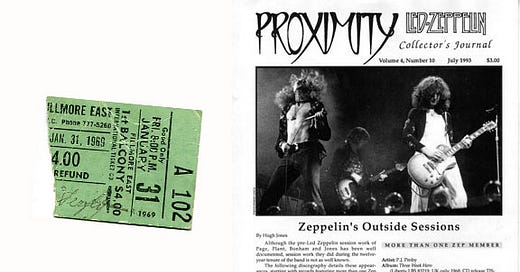



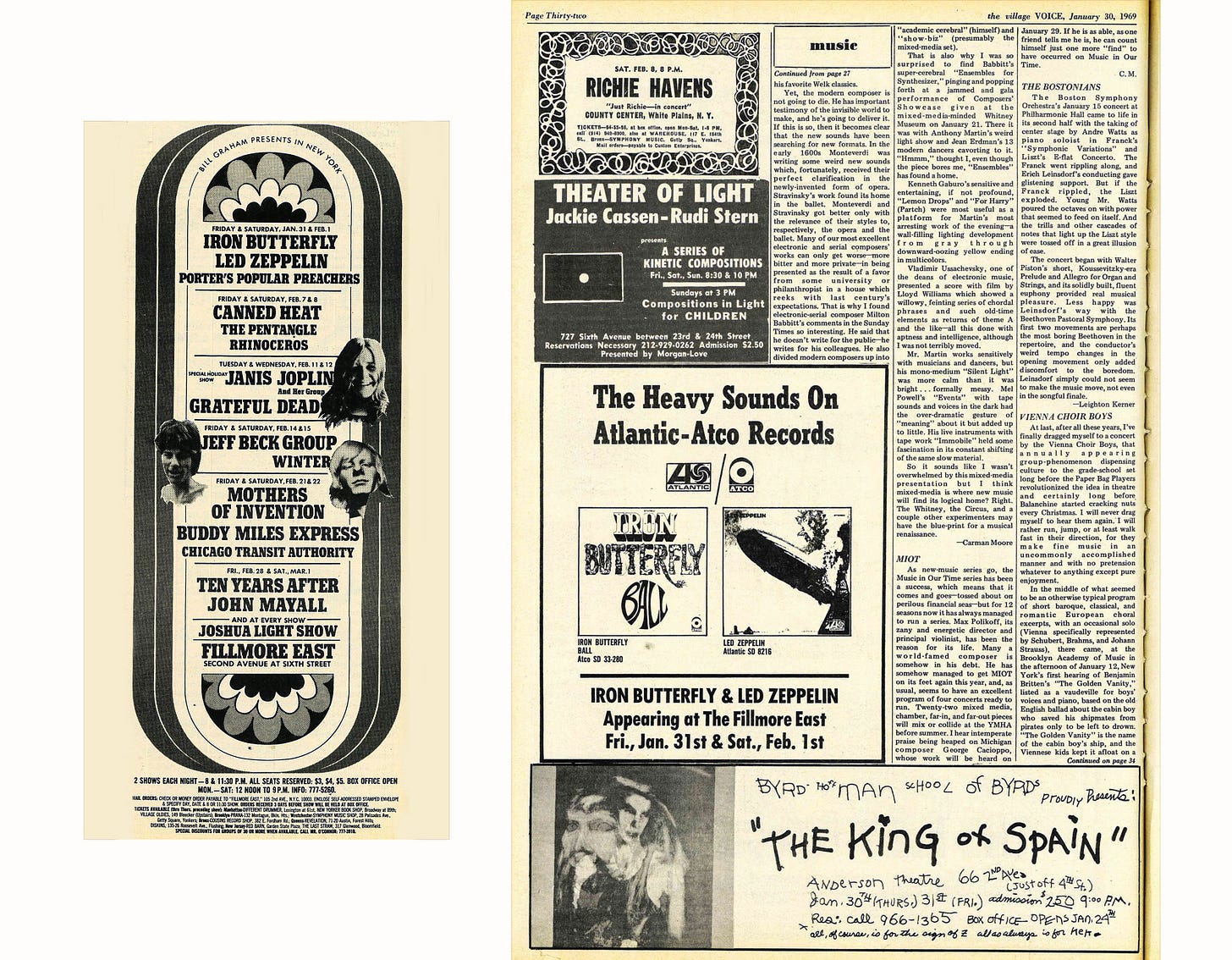
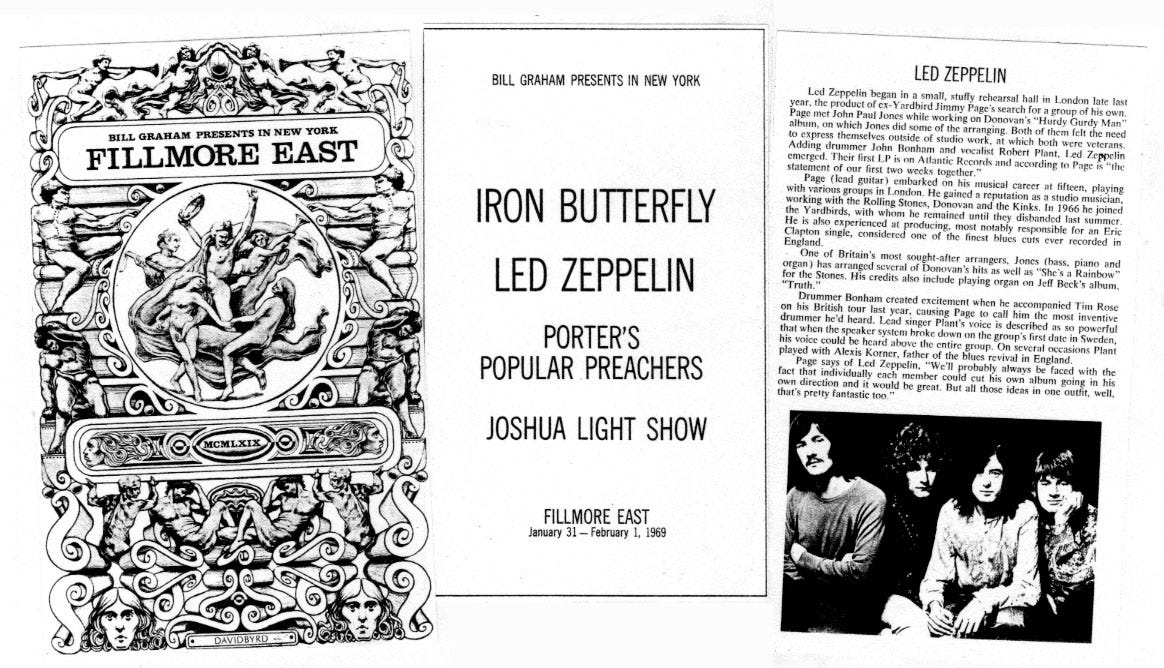
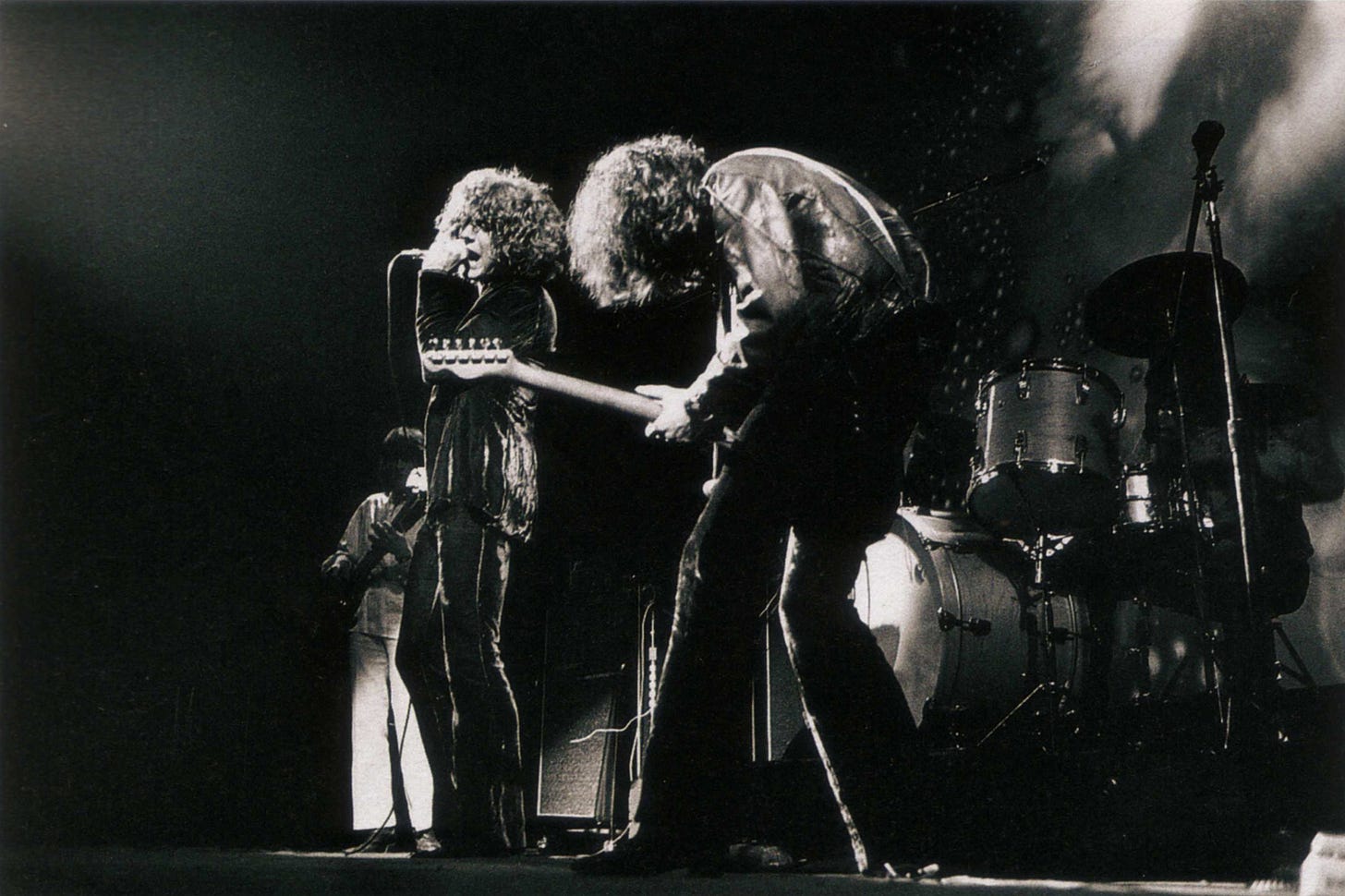
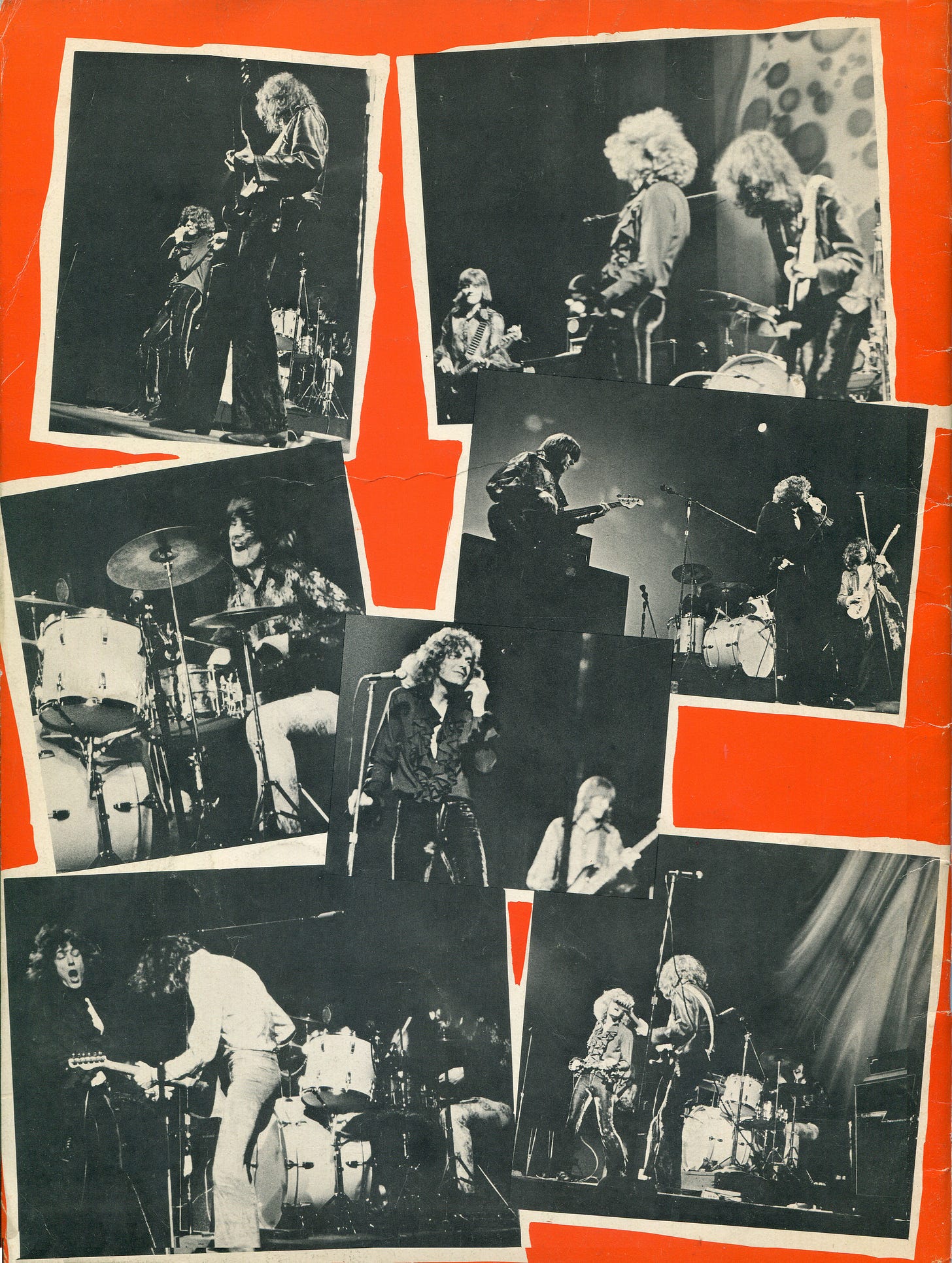
Great review, like actually being there.
Thanks for sharing the ads and program -- I just love the graphic design in that era.
Excellent review of what sounds like a spectacular and life-changing event. I was three days old when you were at that concert! 😎